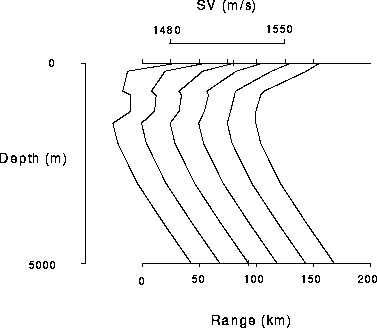 depth and
at zero range, shows up as a zone of increased sound speed.
depth and
at zero range, shows up as a zone of increased sound speed.
Range-dependence can occur as both bathymetric variation (due to
seamounts, continental slopes) and variation in material properties
(due to oceanographic features such as fronts and eddies or to
changes in bottom type). We consider a flat-bottom problem involving
an eddy with a source located roughly above the center of the eddy.
The actual sound speed profiles are shown in Fig. 2.14. The
warm-core eddy which is centered at roughly  depth and
at zero range, shows up as a zone of increased sound speed.
depth and
at zero range, shows up as a zone of increased sound speed.

Figure: Sound speed profiles taken through the eddy.
Figure 2.15 shows plots of the transmission loss obtained with a)
range-independent normal modes using the first SSP throughout, b)
coupled mode theory and c) adiabatic normal modes. The source
frequency is  and the source depth is
and the source depth is  .
The range-independent calculation in Fig. 2.15(a) shows deep-cycling
convergence-zone paths. A band of energy is also seen to propagate
in the duct that is roughly centered at the source depth in the
first profile.
.
The range-independent calculation in Fig. 2.15(a) shows deep-cycling
convergence-zone paths. A band of energy is also seen to propagate
in the duct that is roughly centered at the source depth in the
first profile.

Figure: Transmission loss for the eddy problem using (a) range-independent,
(b) coupled and (c) adiabatic mode theory.
The one-way coupled-mode calculation in Fig. 2.15(b) shows that as
the duct disappears in range the energy passes into the main SOFAR
duct. The result is a great increase in transmission loss for a
receiver located at, for instance,  depth. Thus, in this
particular case a range-independent calculation would almost
certainly be considered inadequate.
depth. Thus, in this
particular case a range-independent calculation would almost
certainly be considered inadequate.
The faster adiabatic calculation shown in Fig. 2.15(c) provides an intermediate result in terms of accuracy: it correctly shows the transition of energy from the near surface duct into the main SOFAR duct but fails to reproduce the details of the pattern. Whether this result would be considered adequate depends on the application.
The adiabatic approximation provides accurate predictions when the
range-dependence is sufficiently weak. What constitutes ``weak''
range-dependence? This is a question which has been addressed in
numerous papers but is difficult to answer in any general sense. In
some cases the adiabatic approximation provides very poor results. An
interesting example of such a problem is obtained by introducing a
seamount into our eddy problem. If the seamount is placed in the
shadow zone between 100 and  then the convergence zone
paths will pass over it unaffected. If the seamount is placed in the
ensonified area centered at
then the convergence zone
paths will pass over it unaffected. If the seamount is placed in the
ensonified area centered at  then the convergence zone
paths will reflect off the seamount and be displaced in range.
However, past the seamount the adiabatic formula depends only on the
integral of the wavenumbers and is therefore insensitive to the
location of the seamount. Despite these problems, the adiabatic
approximation is frequently very useful.
then the convergence zone
paths will reflect off the seamount and be displaced in range.
However, past the seamount the adiabatic formula depends only on the
integral of the wavenumbers and is therefore insensitive to the
location of the seamount. Despite these problems, the adiabatic
approximation is frequently very useful.